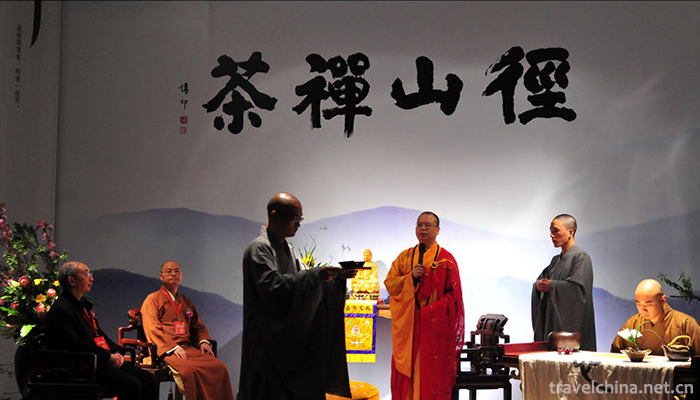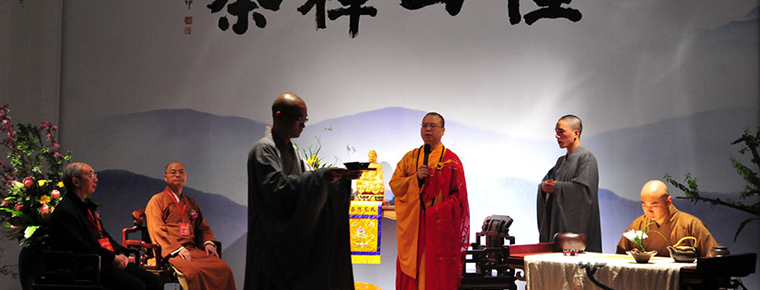Jingshan tea banquet
Jingshan tea banquet
Jingshan Tea Banquet, born in the Longevity Chan Temple of Jingshan, Jingshan Town, Yuhang District, began in Tang Dynasty and flourished in Song Dynasty. It has a history of more than 1200 years. It is a unique tea-drinking ceremony of Jingshan Ancient Temple, which replaces wine with tea. In 2005, Jingshan Tea Banquet was included in the list of representative works of intangible cultural heritage in Yuhang District.
On May 23, 2011, Jingshan Tea Banquet was approved by the State Council to be included in the third batch of national intangible cultural heritage list.
Historical origin
In Song Dynasty, many emperors built Zen monasteries. When they met the celebration or prayer meeting when the imperial court gave them robes and tin canes, they often held a grand tea banquet to entertain guests. The participants were all monks of the monastery and local celebrities. The "Jingshan Tea Banquet" of Jingshan Temple in Yuhang, Zhejiang Province, is well-known for its wild interest in mountain forests and high charm of Zen forests. During the tea banquet, Buddhist disciples gathered around the "Tea Hall", and the order of the tea banquet and Buddhist rituals, ordered tea, offered tea, smelled scent, tasted and expressed friendship in turn. Firstly, the abbot personally poured the fragrant tea "Buddha tea" to show his respect and called it "order tea"; then the monks consecutively dedicated the fragrant tea to the guests, named "offer tea"; after the banquet, the banquet participants first opened the cup to smell the fragrance, then raised the bowl to appreciate the color and luster of the tea soup, and then opened their mouths to taste in the praise of "click". After three tours of tea, they began to appreciate the fragrance and color of tea and praise the moral character of the master. Finally, they talked about Buddhist chanting and narrative friendship.
The culture of Zen tea in Jingshan Temple can be traced back to Tang Dynasty. The monks held tea banquets, ritualized Buddhas and practiced Zen, and formulated unique etiquette. In the Song Dynasty, its influence covered the south of the Yangtze River, and it was known as the "first Zen forest in the southeast" and became the center of Zen tea exchange between China and Japan. Lu Yu, the "Tea Sage", once lived in seclusion at the foot of Jingshan Mountain and wrote down the famous "Tea Sutra".
As a model of the combination of Zen rules and tea party etiquette in China, Jingshan Tea Banquet includes more than 10 ritual procedures such as Zhang Chabang, beating tea drums, respectful invitation to the hall, Shangxiangli Buddha, fried soup and ordering tea, traveling tea, saying and eating tea, thanking tea and withdrawing from the hall, etc.
Chinese and Japanese Tea Culture
Jingshan has been the window and bridge of Sino-Japanese cultural exchanges since ancient times. Jingshan tea banquet is the important content and main carrier of cultural exchanges between the two countries, as well as the origin of Japanese tea ceremony. During the Song and Yuan Dynasties, there were frequent exchanges between Chinese and Japanese Zen monks. Cao Dong Sect and Linji Sect, the popular Zen sect in the south of the Yangtze River, spread eastward to Japan, established sects and extended in Guaku. Among the 24 sects of Zen that appeared in the period of Shimura Shogunate in Japan, 20 sects came from Linji, and 13 of the 14 sects of Zen formed in recent times came from Linji Zen sect, Jishan Sect.
Qian Guangrongxi, a Japanese monk who had been in the Song Dynasty for the second time to seek law, was treated at the Datang Tea Festival at the Jiushan Temple for praying for rain in the capital city. When he returned home, he brought Tiantai Mountain tea, tea seeds, tea planting, tea making technology and tea drinking etiquette. He wrote "A Record of Tea Health", introducing tea planting, tea drinking methods and the effects of tea. He was praised as "Tea Saint" in Japan.
When the Japanese Cao Dong Zong Kaishan ancestor Xixuan Dao entered the Song Dynasty to seek law, he also climbed Mount Jingshan to ask questions. After returning home, he formulated a series of rules and regulations according to Baizhang Qing Rule and Zen Yuan Qing Rule of the Tang and Song Dynasties, collectively known as Yongping Qing Rule. According to the ritual law of Jingshan tea banquet, he made detailed regulations on tea ceremony, such as eating tea, traveling tea and tea soup, which had a far-reaching impact on Japanese tea ceremony etiquette law.
According to the Encyclopedia of the 18th Century in Japan, Sao Ming Nampo, a Japanese monk, introduced the Koyama tea banquet to Japan in 1259. This discovery provides important literature and historical data for the demonstration of the origin of Japanese tea ceremony. From the eighteenth century, the fourth volume of the Textual Research on Analogous Famous Things compiled by Junming Yamaoka, a master of Chinese Studies in the middle of the Edo period in Japan, records: "From the beginning of the tea banquet, in the middle of the first year (1259), the former Chongfu Temple opened the Nanpu Shaoming Mountain, and in the Tang and Song Dynasties, it also went to the Jixutang Temple of the Kiyama Temple, and passed on its law and religion."
This historical record confirms that the Japanese tea ceremony originated from our country's Jingshan tea banquet, and became the "iron evidence" that the Japanese tea ceremony originated from the Jingshan tea banquet.
value
Jingshan Tea Banquet embodies the ancient Zen tea etiquette, is the treasure of Chinese Zen tea culture and etiquette culture, and has high academic value; its tea drinking etiquette shows quiet elegance, delightful spirit, tea tasting and heart-nourishing, tea fighting fun and Buddhist realm is unique, with high artistic value; Song Dynasty, with the spread of Buddhism to Japan, Jingshan Tea Banquet gradually developed into Japanese Tea Tao, Jingshan Tea Tao. Tea banquet is the source of Japanese tea ceremony and an important carrier of cultural exchanges between China and Japan.
Present situation
Jingshan Tea Banquet has been lost for a long time in Jingshan. Since the 1980s, people of insight in Zhejiang Tea Industry have tried to recover and held many ceremonies imitating Jingshan Tea Banquet. Faced with the changes of the times and the impact of powerful culture, the ancient tea drinking etiquette of Jingshan Tea Banquet has been in an endangered state for a long time. It is urgent to rescue and protect it.
Honor
On May 18, 2010, the Ministry of Culture of China announced the third batch of national intangible cultural heritage list of recommended projects (new entries). The "Jingshan Tea Banquet" declared by Yuhang District, Hangzhou City, Zhejiang Province, was selected as the intangible cultural heritage in the category of folk items.


-
1.yangshuo west street
West Street is nicknamed Foreigner's Street, located in Yangshuo County,
Time 2018-10-12 -
2.Huangguoshu Waterfalls Scenic Area
Huangguoshu Scenic Spot is a key national scenic spot, located in southwest Guizhou Province, 128 kilometers away from Guiyang City, the capital of Guizhou Province
Time 2018-12-12 -
3.Guangdong Marine Silk Road Museum
The Guangdong Marine Silk Road Museum is located on the "Shili Silver Beach" of Hailing Island Experimental Development Zone, Yangjiang City, Guangdong Province. The total construction area
Time 2019-01-13 -
4.Hohhot Laoniuwan Tourist Area
Laoniu Bay is located at the entrance of Shanxi-Shaanxi Grand Canyon. This is the Great Wall, the only typical parallel section of the Yellow River. The widest part of the river is not more than 100 m
Time 2019-01-16 -
5.Xishuangbanna Tropical Flower Garden
Xishuangbanna Tropical Flower Garden is located in Yunnan Institute of Tropical Crop Sciences, Jinghong City, Xishuangbanna Prefecture, Yunnan Province. It covers an area of 80 hectares and is one of
Time 2019-02-25 -
6.Yushuizhai Scenic Area
Yushuizhai Scenic Area is a national AAAA level tourist area (spot), located in the north of Baisha Town, which consists of a series of scenic spots. Yushuizhai Scenic Area is a scenic spot with Naxi
Time 2019-03-07 -
7.Acrobatics in Dongbeizhuang
Dongbeizhuang acrobatics is a traditional folk acrobatics in Puyang City. Dongbeizhuang, Yuecun Township in Puyang City, is a pearl in the vast plain of northern Henan Province
Time 2019-04-27 -
8.Gourd sculpture
There are two techniques for carving gourds. One is to use three kinds of special steel needles, large, medium and small, to carve the landscape, flowers and characters in the gourd
Time 2019-05-03 -
9.Gongs and drums
The Gong and drum books used to be called "Taibaoshu", "Taibao" is derived from the activities of "Taibu" in the countryside of Shanghai suburbs and counties, which seeks
Time 2019-05-15 -
10.Sichuan Zhuqin
Sichuan Zhuqin is an ancient traditional opera. The performers hold fishing drums and rap stories. The original name is Mingqin. Because its accompaniment instrument is a bamboo drum drum, it is also
Time 2019-06-16 -
11.Gu Kaizhi
Gu Kai Zhi (348 to 409 years), the word is long, the small character tiger. Han nationality , Jin Ling Wuxi people (now Wuxi, Jiangsu province). Outstanding painter, painting theorist and poet. Becaus
Time 2019-09-07 -
12.Leshan post and Telecommunications
By the end of 2018, there were 253 post offices in Leshan City, with an average of one postal service network for every 50.29 square kilometers and 12900 people. There are 79 postal routes in the city, with a total length of 3490 km. There are 158 urban delivery routes
Time 2020-12-17